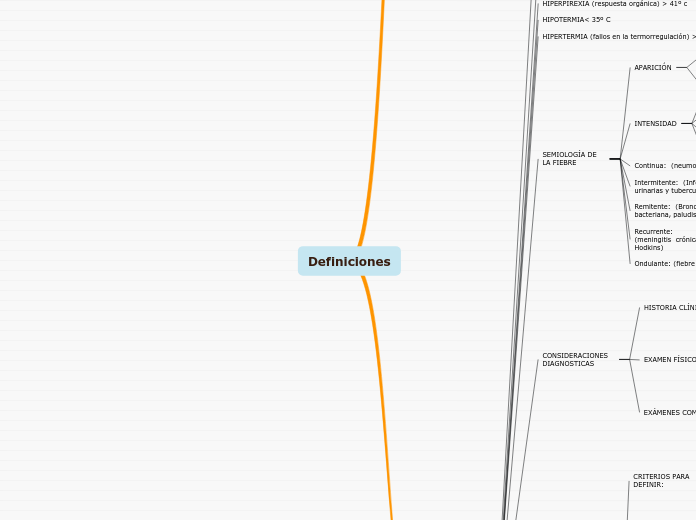по Karina Cauja 4 лет назад
242
Definiciones

по Karina Cauja 4 лет назад
242

Больше похоже на это
Use this template to test your knowledge on some of Medieval Europe's most important events. Write down the names of important figures who have marked history.
Forma simulada de fiebre.
Fatiga, insomnio, cefalea.
Frecuentes en mujeres con temperaturas de 37,4 a 380 C.
Drogas (Progestágenos) Tromboembolismo Pulmonar Tiroiditis Hemólisis
Mononucleosis infecciosa Infección por citomegalovirus Sinusitis Fiebre tifoidea Abscesos dentarios periapicales.
Tuberculosis Abscesos abdominales o pelvianos Endocarditis infecciosa Osteomielitis Infección del tracto urinario
3. Por infecciones bacterianas, respondido al tratamiento a antibióticos.
2. Infecciones virales prolongadas que se autolimitan.
1.Por recuperación (apirexia) espontánea.
Infecciosas Neoplásias Enfermedades del tejido conjuntivo Granulomatosas Enfermedades Metabólicas y hereditarias Otras causas
4.FOD ASOCIADA A VIH
Causas: tuberculosis, neumonía, citomegalovirus, linfoma, Mycobacterium avium-intracellulare etc
Fiebre > de 4 semanas en paciente ambulatorio o más de 3 días de investigación, incluyendo al menos 2 días de cultivos microbiológicos.
Serología para el VIH confirmada.
> o = a 38,30 C.
3. FOD Neutropénica
Causas: Herpes y citomegalovirus
Candida y aspargillus
2. FOD Nosocomial
Causas: infecciones relacionadas con los catéteres, herida quirúrgica, clostridium difficile, tromboflebitis séptica, etc.
Sin diagnóstico después de 3 días de estudios apropiados, incluyendo al menos 2 días de cultivos microbiológicos.
Sin infección o incubación al ingreso.
- > 38,3º C, en paciente hospitalizado por proceso agudo.
1. FOD Clásica
Fiebre > o =38,3º C en varias ocasiones. Fiebre > 3 semanas de duración. No diagnosticada: con 3 consultas ambulatorias o durante 3 días de hospitalización. Causas: infecciones, neoplasias, y reumatológicas
3.TIEMPO DE ESTUDIO, una semana ingresado en el hospital.
2. DURACION, al menos 3 semanas.
1. MAGNITUD, temperatura superior a 38,30 C.
Hemograma Orina completa Hepatograma Hemocultivos Radiografías
Examen minucioso. Comprobar divergencia en la temperatura corporal central y periférica. Signos acompañantes y concomitantes.
Give some examples of royal figures who won their fame in the Medieval Ages.
Think of kings, queens, princes, and princesses.
For example, Eduard IV, also known as the 'Black Prince', became famous for his bravery acts in the war against France.
Adolescentes: enfermedades autoinmunes, infecciones gastrointestinales. Adultos: Neoplasias, enfermedades del colágeno. Antecedentes familiares con fiebre, viajes y consumo de fármacos. Curvas térmicas.
Type in other examples of Medieval artists.
Who is the Italian artist who painted the top of the Sistine Chapel?
This artist is also the creator of the famous sculpture statue of David.
Type in the answer.
HIPERPIREXIA O HIPERTERMIA >41º C
ALTA HASTA 41º C
MODERADA O SIMPLEMENTE FIEBRE 39º C
FEBRICULA: 37,2- 37,9º C
Who was the Italian artist who painted Mona Lisa?
He became world famous for also being a prolific scientist, inventor, engineer, mathematician, and writer.
Type in the answer.
INSIDIOSA O PROGRESIVA
Fiebre tifoidea.
BRUSCA:(Acompañada de escalofríos)
EJEMPLO:Paludismo, neumonía o infecciones urinarias
Who was the English physicist who created the laws of motion that govern all objects, including the force of gravity?
Type in the answer.
Type in other examples of famous scientists who lived in the medieval period.
What scientist claimed that the Earth revolved around the Sun?
He was also put on trial by the Catholic Church for publishing a book with this theory. Type in the answer.
Type in several other examples of people who influenced medieval literature.
Who was the famous Italian writer who advised rulers that “the ends always justify the means”?
Type in the answer.
Who was the English writer who became famous for his plays and sonnets about love, fantasy, betrayal, politics, government, and ancient Rome?
What major event took place in 1066 A.D.?
Type in your answer.
What is the year in which the Vikings were defeated by the King of England, Alfred the Great?
Type in the answer.
OTROS EXÁMENES
Radiografía del tórax.
EXÁMENES DE LABORATORIO
Los exámenes que pueden confirmar la infección son: Hemocultivo Gasometría arterial CSC Estudios de coagulación TP TPT niveles de fibrinógeno Cultivo de LCR Cultivo de cualquier lesión cutánea Conteo de plaquetas Urocultivo
EXAMEN FÍSICO
Presión arterial baja Temperatura corporal baja o fiebre Signos de enfermedades asociadas tales como: meningitis, epiglotitis, neumonía o celulitis. Alteraciones en el equilibrio acido-básico. Bajo funcionamiento de órganos o insuficiencia de un órgano.
INICIO DE LA SEPTICEMIA
Frecuencia cardíaca rápida
Respiración acelerada
Fiebre alta
Escalofríos
Activación de Leucocitos Polimorfonucleares
Lesiones tisulares con disfunción de distintos órganos
What major event took place in 835 A.D.?
Type in the answer.
Charlemagne, also known as 'The King of Franks', is crowned Holy Roman Emperor.
What year did this coronation take place?
What major event took place in 732 A.D.?
Type in the answer.
In what year is Muhammad born?
Type in the answer.
What major event took place in 481 A.D.?
Type in the answer.
SHOCK FRÍO O TARDÍO
Piel viscosa y fría. Cianosis. Pulso débil. (Filiforme) Disminución del gasto cardiaco. Disminución Resistencia Periférica. Hipotensión. Hipoventilación. Oliguria progresiva y obnubilación
SHOCK CALIENTE O PRECOZ
Fiebre. Hiperventilación. Piel seca, roja y caliente. Gasto cardiaco aumentado. Hipertensión. Pulso arterial amplio
Around what year did the Roman Empire fall, thus leaving a lot of local kings and rulers fighting for the land?
Type in the answer.
CUTÁNEOS
Frialdad en la piel y erupciones o lesiones hemorrágicas
ENDOCRINAS-METABÓLICAS
Hiperglicemia
Trombocitopenia Leucocitosis
NEUROLÓGICO
Confusión, agitación o disminución del nivel de conciencia. Reducción de la presión de perfusión cerebral y microabscesos
HEPÁTICO
Elevación de las enzimas hepáticas (Ictericia)
GASTROINTESTINAL
Disminución de la perfusión de la mucosa gastrointestinal. Úlceras digestivas
RENAL
Insuficiencia Renal Aguda Oliguria.
CARDIOVASCULAR
Hipovolemia y taquicardia Permeabilidad capilar aumentada. Vasoconstricción y saturación venosa mixta.
PULMONAR
Síndrome de Distress Respiratorio. SDRA. Hipoxemia.